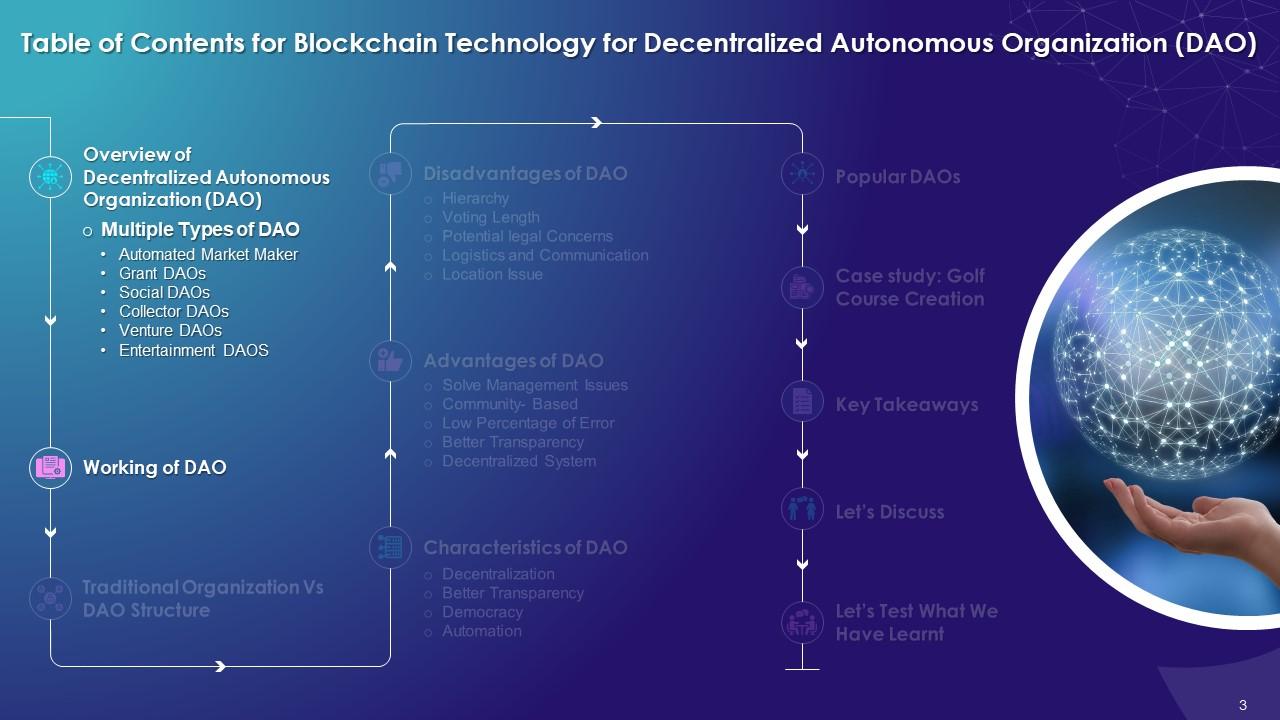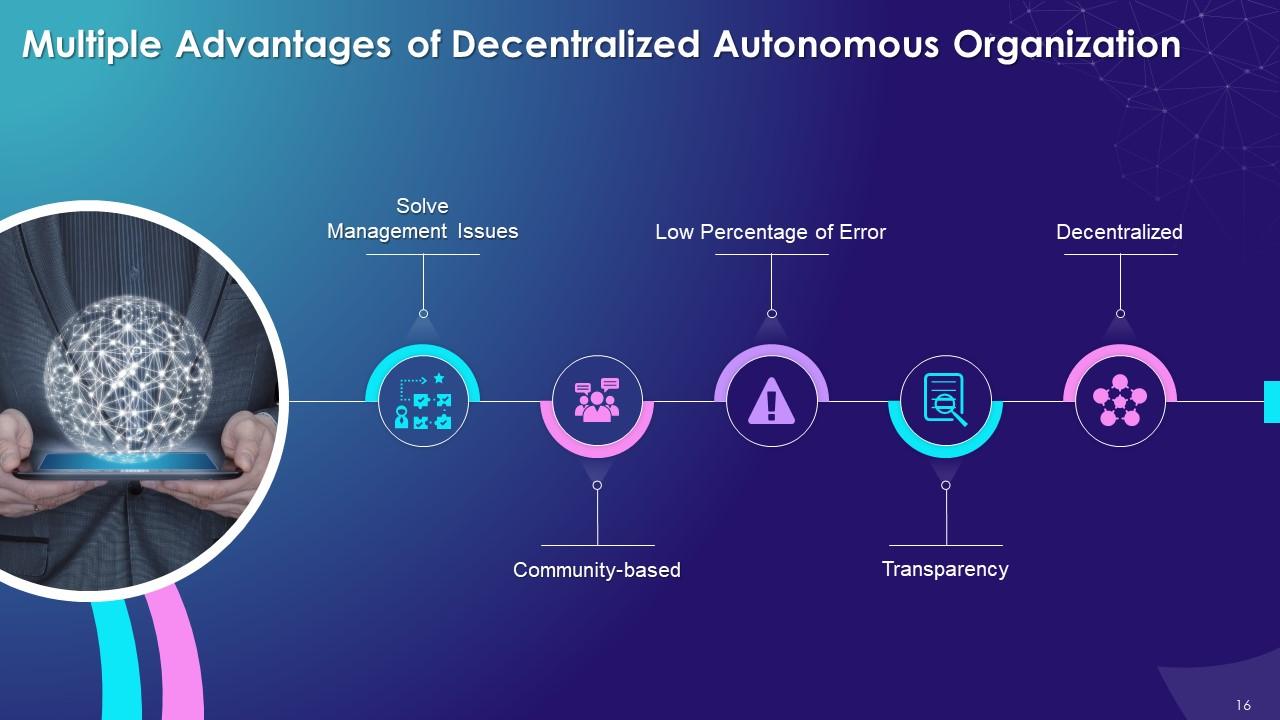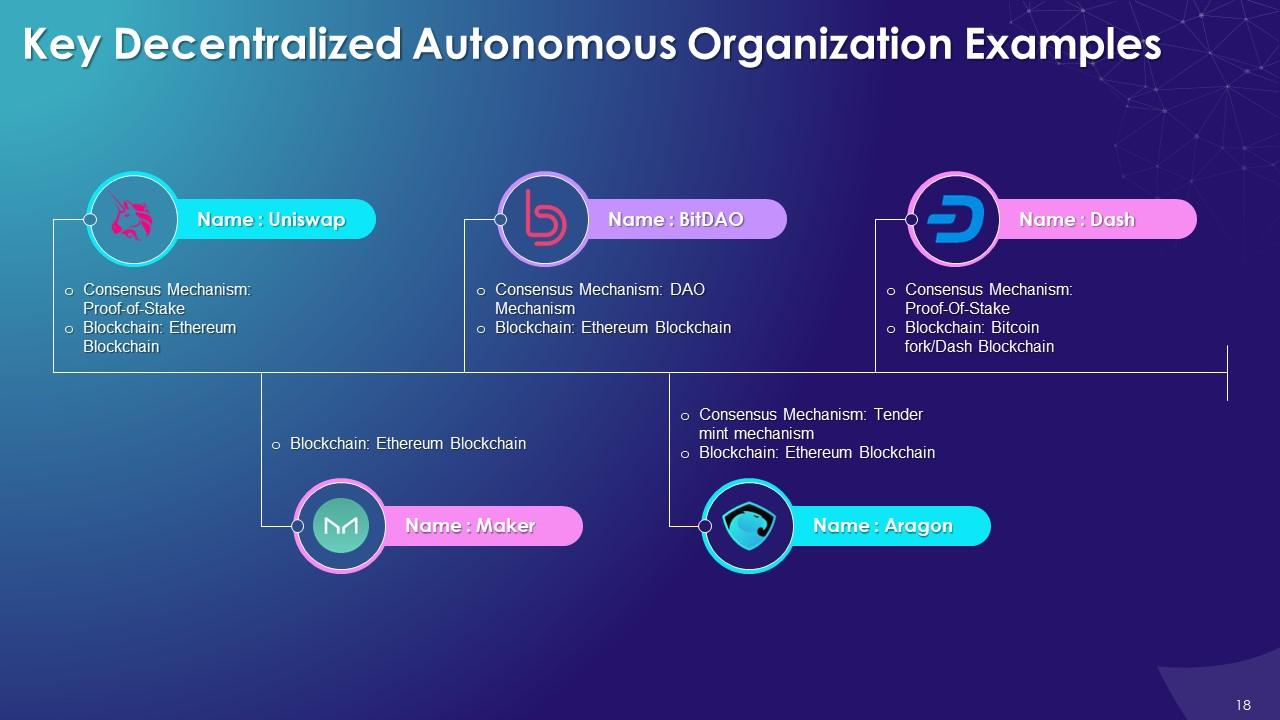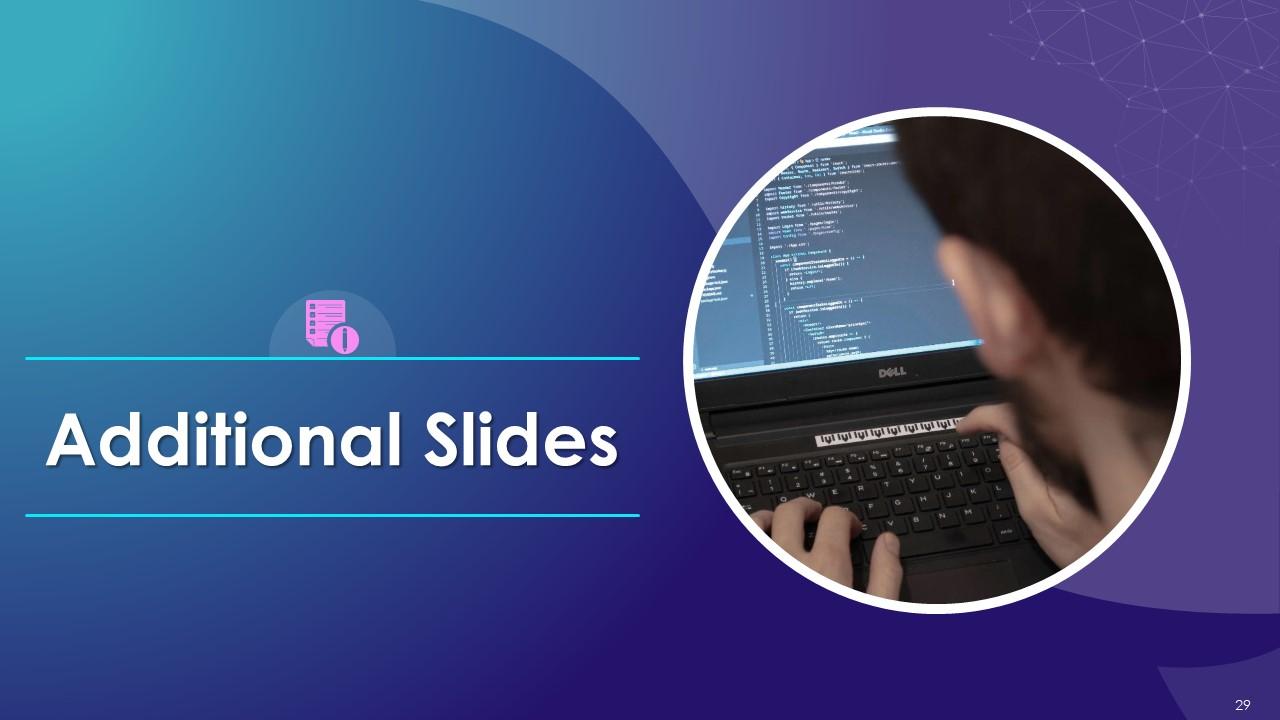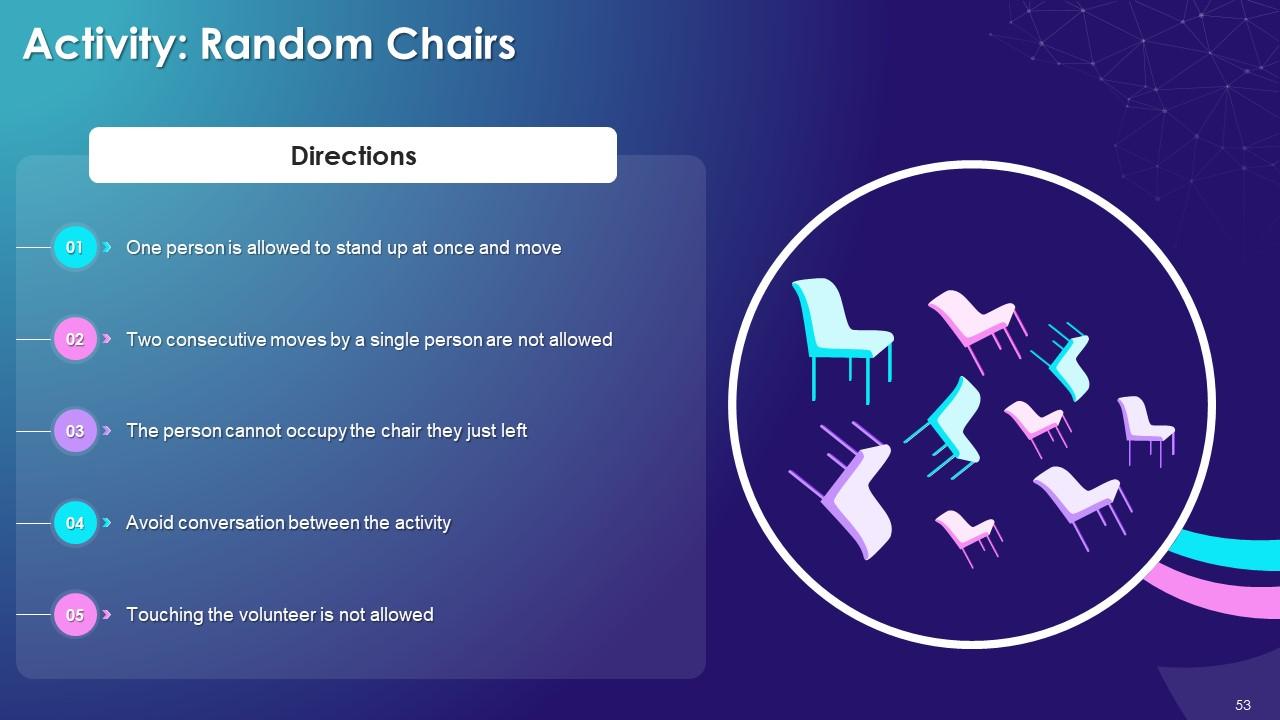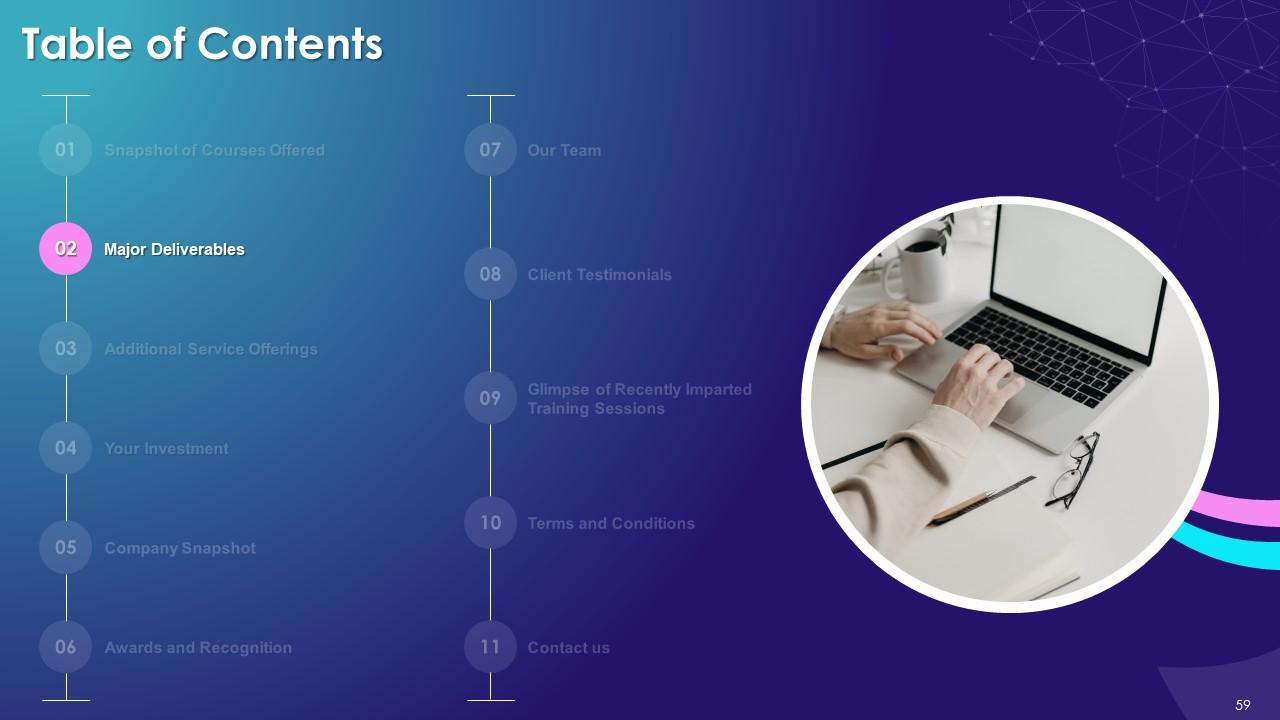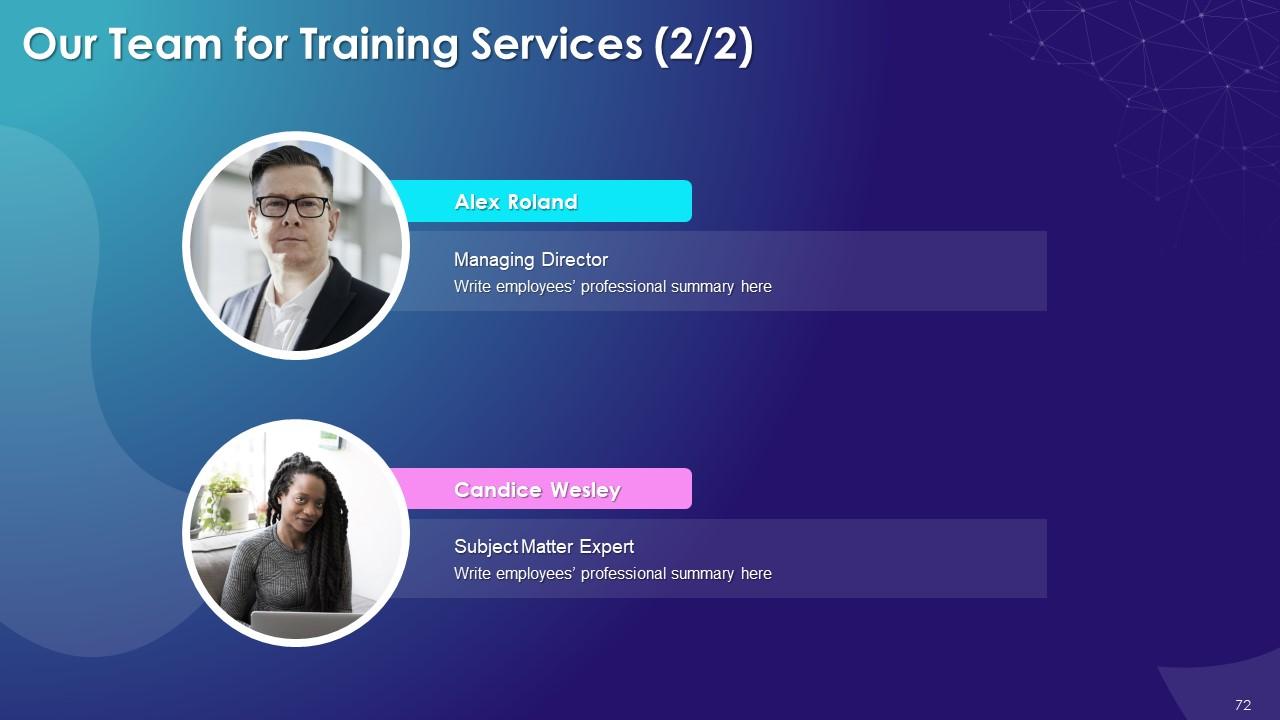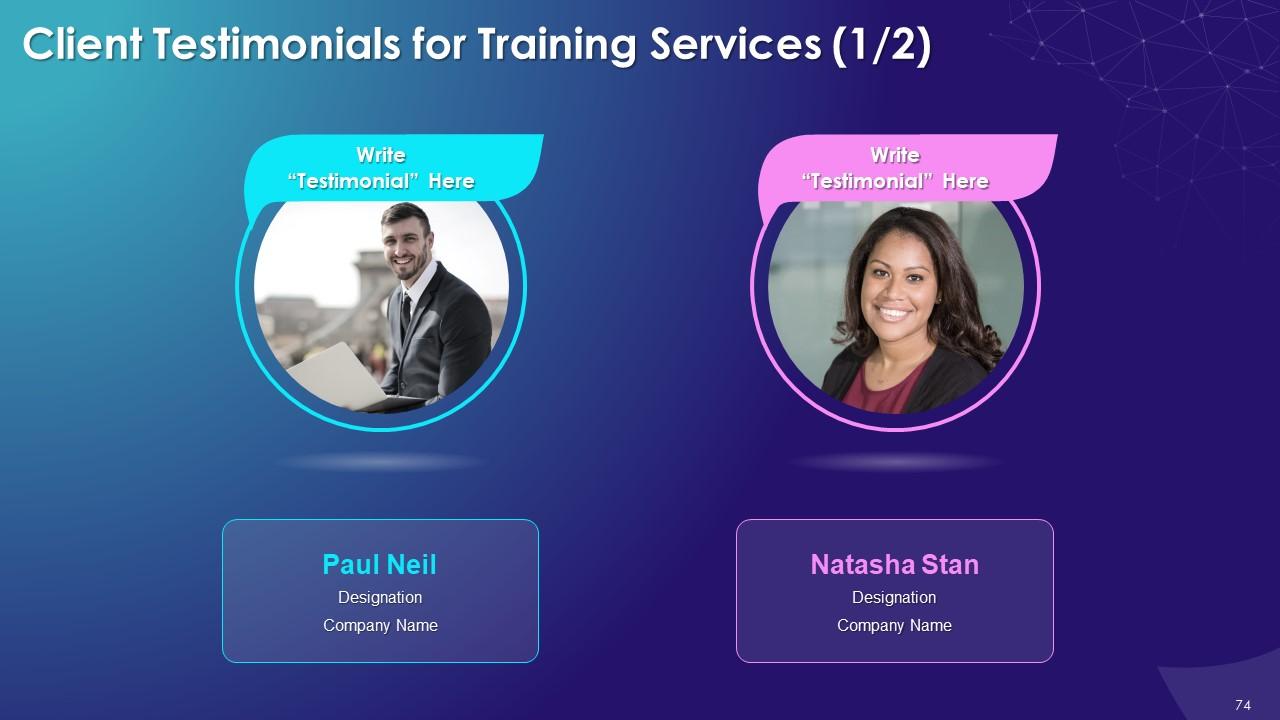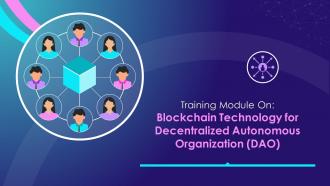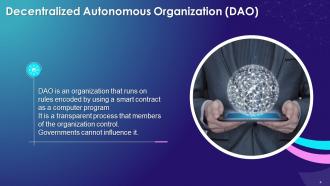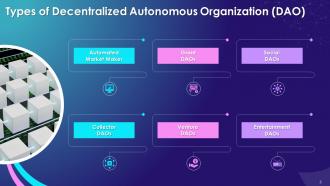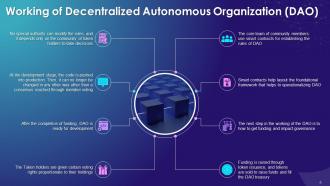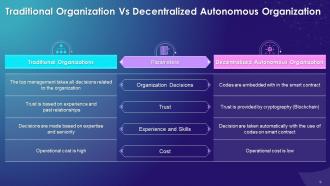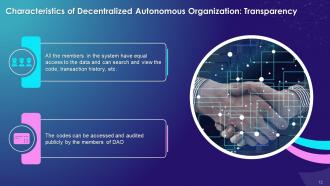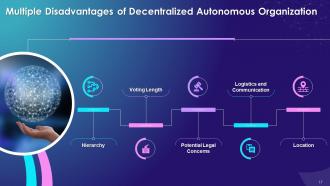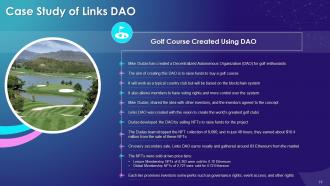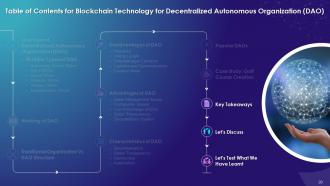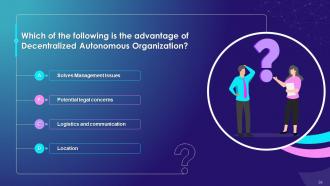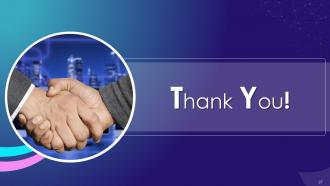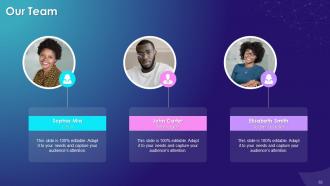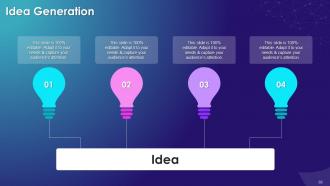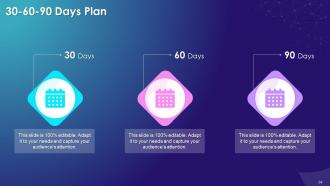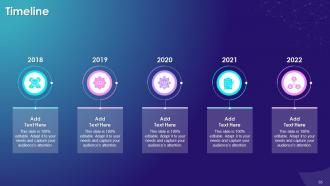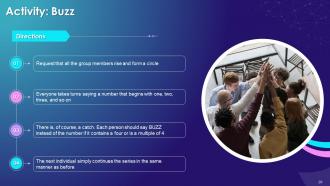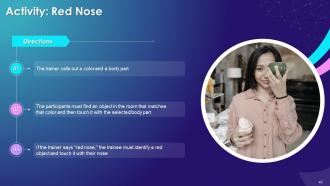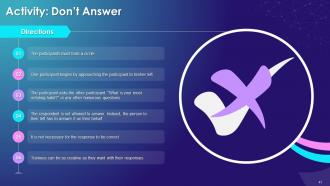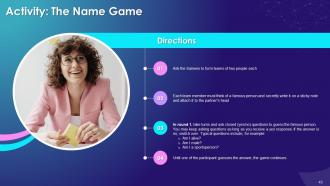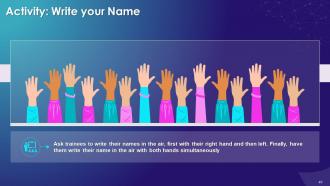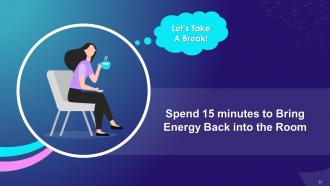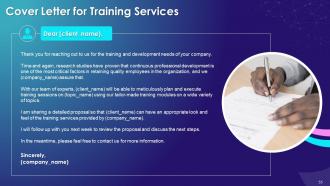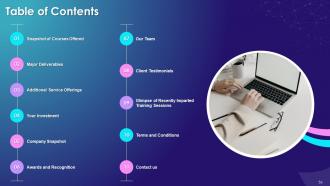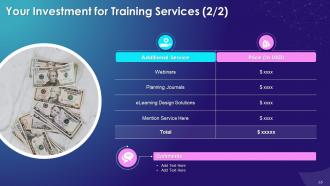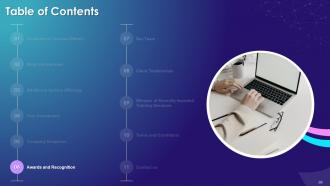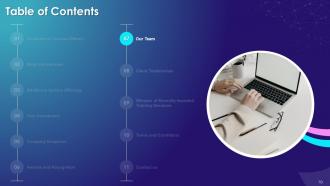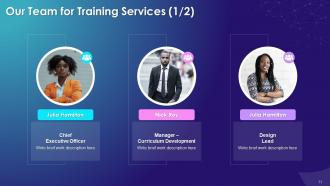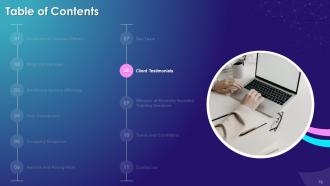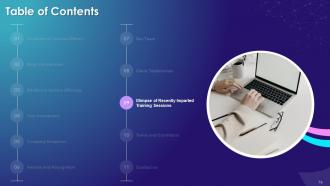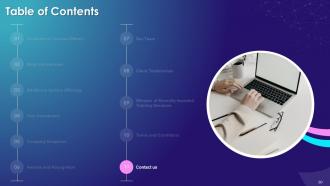Blockchain Technology for Decentralized Autonomous Organization DAO Training Ppt
This PPT training module in-depth covers blockchain technology for a decentralized autonomous organization DAO. It includes multiple types of DAO, such as automated market maker, grant DAO, social DAO, collector DAO, venture DAO, and entertainment DAO. It also covers the working and characteristics of DAO, such as better transparency, democracy, and automation. It also includes PowerPoint slides on DAOs advantages, which are solving management issues, being community-based, having a low error percentage, and better transparency. Further, it covers the disadvantages of DAO, such as hierarchy, voting length, potential legal concerns, logistics and communication, and location issues. The PowerPoint module has key takeaways, a case study, discussion questions, and MCQs related to the topic to make the training session interactive. It also includes additional slides on about us, vision, mission, goal, 30-60-90 days plan, timeline, roadmap, training completion certificate, energizer activities, detailed client proposal, and training assessment form.
You must be logged in to download this presentation.
 Impress your
Impress your audience
Editable
of Time
PowerPoint presentation slides
Presenting Training Session on Blockchain Technology for Decentralized Autonomous Organization DAO. This deck comprises of 84 plus slides. Each slide is well crafted and designed by our PowerPoint experts. This PPT presentation is thoroughly researched by the experts and every slide consists of an appropriate content. All slides are customizable. You can add or delete the content as per your need. Not just this, you can also make the required changes in the charts and graphs. Download this professionally designed business presentation, add your content and present it with confidence.
People who downloaded this PowerPoint presentation also viewed the following :
Content of this Powerpoint Presentation
Slide 4
This slide highlights the concept of decentralized autonomous organization. It explains the use of smart contract in making rules for DAO and it is a transparent process that members of the organization control.
Slide 5
This slide highlights different types of Decentralized Autonomous Organization such as automated Market Maker DAOs, grant DAOs, social DAOs, collector DAOs, venture DAOs, and entertainment DAOs.
Instructor’s Notes:
The multiple types of DAOs’ are as follows:
Automated Market Maker:
- Automated Market Maker (AMM) uses smart contracts to provide decentralized financial services to its users
- Maker DAO is one of the most successful and innovative apps on Ethereum
- Maker helped their users to actively take part in the global financial system
Grant DAOs:
- The earliest use case of DAO is Grants
- The community donates funds and receives tokens in return
- The doners collectively vote on the allocation and distribution of funds
- The purpose of using DAO is to fund innovative DeFi projects and other organizations submitting applications for a research grant
- The development of grant-based DAOs are practical examples that shows that decentralized communities are more flexible in funding distribution than traditional institutions
- Aave protocol is a well-known DAOs using grant infrastructure to nurture and build a community of DeFi projects
Social DAOs:
- This form of DAO community is built to focus on particular objectives such as preserving arts and culture
- It helps to unify artists and cultural thinkers with a shared set of values and incentives, allowing them to connect and collaborate
Collector DAOs:
- In collector DAOs’, pleasr DAOs helps to acquire cultural collectables for its community
- It also distributes the ownership of various high-ticket digital assets equally among all the members of the community
- It also falls under the category of investment DAOs
Venture DAOs:
- Venture DAOs, also known as investment DAOs, are transparent, inclusive and often open to anyone anywhere
- Many traditional investment firms are elitist and non-inclusive
- DAO removes all the barriers and lets the regular people invest in extraordinary projects
- When thousands of people invest in this type of DAO, it becomes possible to invest in projects that were earlier reserved for the upper echelon of traditional investors
Entertainment DAOs:
- Entertainment DAOs creates an outlet for the artists within us
- It can bring creative minds from around the world to come together to make exciting and creative projects
Slide 6
This slide illustrates the working of a Decentralized Autonomous Organization. It explains that smart contracts are used to establish DAO. We also showcase that raising funds and bestowing governance rights are major challenges in DAO.
Slide 8
This slide compares the structure of traditional organization with a Decentralized Autonomous Organization. It explains that in a traditional organization, the senior management takes all decisions and the subordinate staff is excluded from the decision-making process. On the other hand, in a Decentralized Autonomous Organization, there is no hierarchy, and all decisions are through the process of voting. All DAO members vote based on their contribution to the blockchain system.
Slide 9
This slide compares a traditional organization and Decentralized Autonomous Organization. It is explained on parameters such as organization decision, trust, experience and skills, and cost.
Slide 10
This slide highlights distinct features of Decentralized Autonomous Organization such as decentralization, transparency, democracy, and automation.
Instructor’s Notes:
Multiple characteristics of a Decentralized Autonomous Organization are:
- Decentralization: In a Decentralized Autonomous Organization, members/stakeholders take all decisions for the system
- Transparency: All members in the system have equitable access to data and can search and view the code, transaction history, etc.
- Democracy: In DAO, the smart contract takes all decisions via an open voting system in which all members can participate
- Automation: All operations are executed automatically with a smart contract through rules programmed into it
Slide 11
This slide showcases decentralization as a characteristic of the DAO. It explains that members/stakeholders of the system take all decisions
Slide 12
This slide illustrates transparency as a characteristic of the DAO. It explains that all members in the system have equitable access to data and DAO members can also access and publicly audit the code that underlie smart contract rules
Slide 13
This slide showcases democracy as a characteristic of the DAO. It explains that it is the smart contract that makes all decisions via an open voting system in which all members can participate
Slide 14
This slide highlights automation as a characteristic of the DAO. It explains that all the operations are done automatically using a smart contract by following the programmed rules
Slide 16
This slide highlights benefits of Decentralized Autonomous Organization such as resolving management issues, community-based, low percentage of error, transparency, and decentralization.
Instructor’s Notes:
Multiple advantages of Decentralized Autonomous Organization are:
Solve Management Issues:
- DAO can help improve the management of many traditional organizations by implementing an autonomous structure
- The problem with traditional organizations is that they operate top-to-down that works to invalidate the contribution from anyone that is not at the top of the pyramid
- Every investor in DAO has the opportunity to shape how the organization should run
Community-based:
- DAO has a flat structure with little to no management structure in place
- All decision-making powers are given to token holders in the system
Low Percentage of Error:
- Once the rules governing a DAO are finalized through smart contracts, all decisions are enforced automatically without the requirement of any human input
- It also helps to reduce the risk of errors as the human factor is eliminated
Transparency:
- DAO is considered as a decentralized governance structure
- With the help of DAO, one can get rid of managerial staff through system automation
- In DAO, information is publicly available, and does not have to wait for a human to provide it
Decentralized:
- DAO is decentralized as no single person or entity has complete control over it
- It does not have any central point of failure
- It eliminates all uncertainties and helps increase participation and security because all members of the DAO share the ledger
Slide 17
This slide highlights the different cons of Decentralized Autonomous Organization such as hierarchy, voting length, potential legal concerns, logistics and communication, and location
Instructor’s Notes:
Multiple disadvantages of Decentralized Autonomous Organization are:
Hierarchy:
- Voting power can be stacked through the accumulation of tokens
- If holders have more governance tokens than others, such holders can take decisions and undermine the influence of the minority
- These actions indicate that hierarchy cannot be entirely eliminated by DAO's structure
Voting Length:
- DAO works on a community-based model, and all the decisions are made based on the voting system
- If there is an error in the code or a security breach because of that error, no action can be taken without the organization's consensus
- The error remains unfixed and valuable time would slip away until the community organizes a vote on how to fix the error
Potential legal concerns:
- In DAO, some potential legal issues can arise based on governing jurisdictions of DAOs between members or externally with regulatory compliances
- DAO is a novel organizational structure, and some questions based on liability can arise for members
Logistics and communication:
- DAO operates via communication platforms such as discord and telegram, which makes communications more difficult than mainstream avenues
- DAO has virtual and autonomous nature, which leads to practical hurdles in executing transactions with traditional businesses
Location:
- Members in DAO can be from all around the world
- There can be a legal obligation regarding the jurisdiction of DAO
- In DAO, laws and treaties have not yet been formalized because of their novelty
- The legal jurisdiction over a DAO could be based on where its members are physically located
- The anonymity of members in DAO can be a hurdle to their continuation
Slide 18
This slide highlights examples of Decentralized Autonomous Organization such as Uniswap, Maker, BitDAO, Aragon, and Dash. It also provides information on their consensus mechanism and blockchain used.
Slide 19
This slide showcases the use of DAO to raise funds for the creation of a golf club. It explains that Mike Dudas along with his investors created a Link DAO to raise funds for the development of golf course by selling NFTs in return for raising funds.
Slide 39 to 53
These slides depict energizer activities to engage the audience of the training session.
Slide 55 to 81
These slides consist of a client training proposal highlighting what the company providing corporate training can accomplish for the client.
Slide 82 to 84
These slides highlight the training evaluation form for instructor, content, and course assessment.
Blockchain Technology for Decentralized Autonomous Organization DAO Training Ppt with all 89 slides:
Use our Blockchain Technology for Decentralized Autonomous Organization DAO Training Ppt to effectively help you save your valuable time. They are readymade to fit into any presentation structure.
-
Wonderful templates design to use in business meetings.
-
Innovative and attractive designs.





